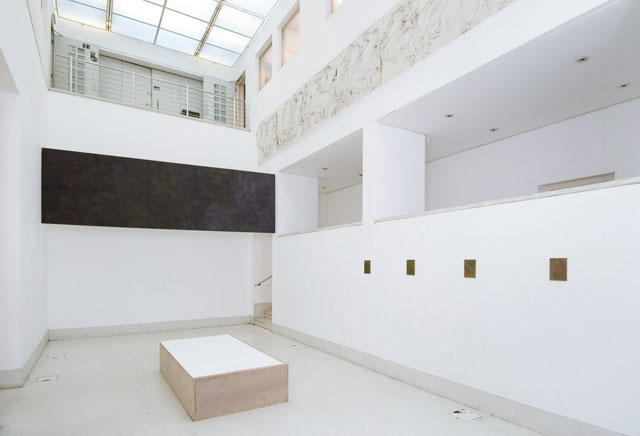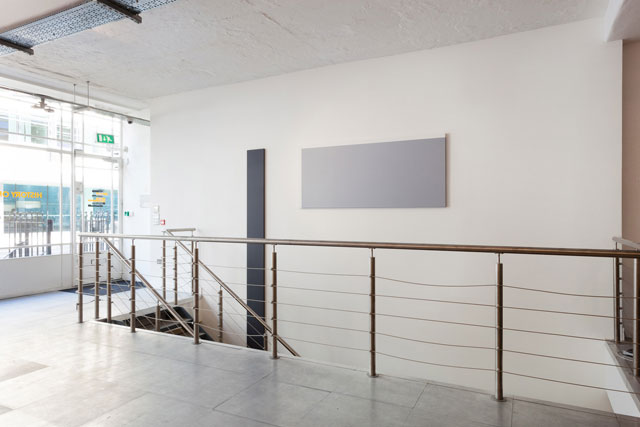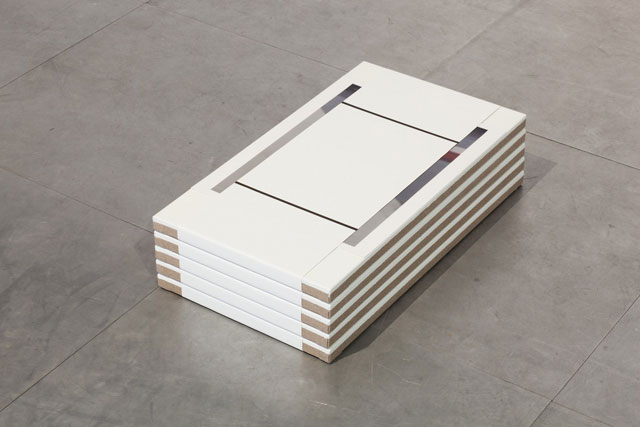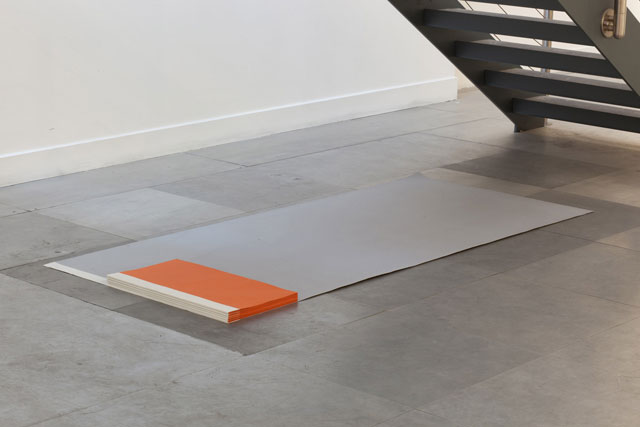Lewis Ronald: The idea of these conversations is that they are about one work, although I feel it doesn’t make sense to talk about one work with you. You said last week in relationship to a past show, a group show in fact, that you had made a body of work – and didn’t you just title that body of work as a whole?
Ian Law: Well, the title of the work in the David Roberts [Art Foundation] exhibition was the same used in the Hockney Gallery show at the Royal College [of Art]. The large painting from that show, and the scale of it, was transplanted, taken directly to the second space. The title of the exhibition was Prelims and then the David Roberts work was titled Prelims, only the date was different.
LR: Then, the works, do they have titles?
IL: No, it all came under the same title.
LR: So was it all one work?
IL: Prelims is a work that can move. Material was carried over from the first to a second show, and could be shown a third time now. The work changes each time but certain dimensions are retained, which refer to, for example, the width of the space.
LR: So the height of the stretcher that ran down in the stairwell [at DRAF] was the width of the stretcher hung from wall to wall across the Hockney Gallery?
IL: It was the same piece of fabric, repainted.
LR: We've previously spoken about pattern cutting. Would you say in this work that you are making patterns in that sense?
IL: You could relate to that, but there is also a simple necessity to the act of taking the painting apart, to move it when an exhibition ends, especially when you’re making something to fit a space. In applying it to the second space, width became a height and the new width came from another document that I had been working with. So in subsequent exhibitions the second large painting would retain a DRAF measurement but then take on a new dimension before being installed alongside the first. But the installation could become more flexible.
LR: But you repaint them, so they are not the same painting?
IL: They accumulate layers of paint.
LR: Like a building might? So it becomes a record of its own exhibition.
IL: Yes, but not by literally showing this layering process. You could look at it in terms of addressing a space, for a certain period of time. Unlike a wall painting where it will be painted over, it's about a two-way relationship, a painting for a space and a space for a painting.
LR: Which is quite sculptural.
IL: I would say that how it is made is much more important. It is made as a painting, utilising the standard wooden stretcher construction. It's more about the previous exhibition space, setting out a size for a painting shown in a new space.
LR: So you would say we would have to speak about the entire project Prelims as a work in itself? Rather than for instance just the first large stretcher that went on to be reused?
IL: If we were speaking at the end of 2008 and that's all that there was to go on then yes, but now there is this history and second location, it is something that has a potential to move forth and beyond.
LR: Like in history more generally, you can't talk about something that happened in the past in the context of the past any more, its impossible. But also it wouldn’t make any sense. Say you were to make a retrospective film you cannot possibly make it in the mind-set of that time.
IL: The director of the film has lived a life beyond that period...
LR: A singular piece of work of yours that I know well is the green stretched t-shirt, which is called Rig?
IL: Even this piece has been removed from something, something that is worn on a daily basis.
LR: It literally is like a pattern, a deconstructed t-shirt is like pattern making.
IL: [Pulling out a bag of t-shirts] I’m just taking these to the studio, you remember the batch of paper I put through the wash last week? Well these were put in the machine one at a time after this, to ensure the drum was clean. There’s a variety of tone dependent on the order they went in to the machine, and how many times I wore them. With the green t-shirt work that you mentioned, I bought two shirts specifically, and photographed Alex and Sabina wearing them in the studio. In terms of painting, having this movement across surfaces is interesting to me, rather than within one surface, and perhaps the use of t-shirts – these basic items of clothing – will be something that I continue to use as a way of noting the viewer within the space of these surfaces. It’s starting to revolve around the actual object being involved in the life of the person, and ways in which that could happen – the art object being this fluid thing.
LR: All these works I think of, they are ending up as surface. But it was interesting when you just got out these t-shirts because you have kind of made editions out of (literally) the residue of a previous work. But in fact that’s just my assumption - in fact you are still dealing with making surfaces.
IL: They’re going to retain their form as t-shirts, but they are going to be held in place in a stack, like the work I showed at David Roberts.
LR: The materials are going through these different actions, performing roles, and their function is being shifted between shows and your studio.
IL: Well this is a domestic process that the t-shirt would already be involved in, the t-shirt hasn’t been dyed, so much as it’s been placed in the washing machine, but there is already this residue in the machine, that shouldn’t be there, kind of being emptied upon it.
LR: We’re talking about how they’re made, and processes involved, but when they end up on display they are always inert.
IL: The exhibition space is this resting period for the works, an opportunity to get some distance from the process in which they’re made. I’m able to set them in relation to others, so that the audience can have this to-ing and fro-ing in a simple set of formal associations that take the viewer across the space.
LR: Photography tends to help with that doesn’t it? When you introduce the photograph it tends to be a record of an action that has taken place.
IL: Yes, and this action is specific to what’s happening within the space, and the painted surfaces. Having a photographic image amongst a set of surfaces goes some way to orient or locate the viewer, themselves, within the space of the works. There needs to be an attention paid to the act of looking and working from one surface to the next.
LR: Do you think about the viewer a lot?
IL: At the moment I am considering how the work is received much more, especially as I work on these two shows concurrently.
LR: Do you mean just to be aware of it or is it integral to the function of the work?
IL: I’m not so interested in the viewer participating in such a direct physical way, like having the t-shirts on hangers and they can try them on, dance, etc – I’m more interested in opening up and presenting a working process. The photographic documentation of these activities could play a more important role and could be applied to a couple of surfaces - this is what I’ve been thinking about with table trestles. There’s an opportunity to have a painting on a stretcher, functioning as a tabletop - but being on trestles it’s rested – it’s not fixed forever – so it could be tipped up on to a wall. Also, can a text be integrated in to these surfaces? The previous installations have all been rigorously constructed around the paintings; these really formal associations to do with size, scale and location. But now perhaps this relationship will change by showing and being discursive about each process and movement, finding a way of integrating other things, like short videos made in the studio, into a surface which doesn’t just become this record of a series of stages. Maybe this documentation can become much more integrated in the final installation.
LR: I remember in your [RCA] degree show the singular photograph operated in that way. But going back to that green t-shirt, I was thinking it gives away very little, you have to go up to it very close to see it for any more than a colour square - a colour field, to use the parlance! But with that necessity to go close to inspect it, by going close you discover the materiality of it, which is more a sculptural device isn’t it? To find that what at first appears as painting is actually found object.
IL: I guess when I’m making these works in the studio I don’t think about whether it’s becoming a sculptural thing I’m just thinking this really makes sense in regards to...
LR: Is that why the installation ends up being called one thing?
IL: In this case it was...Rig...
LR: And it’s about the collection of signs, the collection of objects, rather than the one. Is that the problem with taking one item out of the display?
IL: Well individually there were some titles… but was that one untitled and just signed… I can’t remember? But in regards to me having a sculptural practice I don’t think of what I do in those terms because by moving something from the wall to the floor... If I’m thinking of the exhibition space as this location where works are in relation to each other and are resting in this space then I don’t necessarily think by me putting paintings on the floor they suddenly...
LR: No, but I don’t think that’s so much what I meant, I was thinking about it in terms of materiality. It’s difficult to persuade someone that it is painting, it’s a coloured T-shirt, a found object, you’ve bought it... you haven’t painted it. Did you wear it?
IL: Alex or Sabina wore it for the photographs, and it wasn’t washed.
LR: It’s got sweat stains?
IL: No! The shirts were only worn for less than half an hour. But some of these pinkish ones have been worn for over a year, some are new... I would still wear them. The process of having things come in and out of an exhibition, back into some kind of regular daily routine is highly appealing. And reassuring…
LR: It looks like you haven’t actually got all of the pink out of the washing machine
IL: It definitely is - I put these in at a 95° wash! My flatmate has since done a load and all is fine. It was more problematic when I put the Am Nuden Da painting in the wash because loads of paint came off in the machine…
LR: So going back to ‘Prelims’ you spoke of it as an introduction to your practice, which was quite neat for the purpose of this conversation.
IL: That was the starting point for this work – I realised that making large processed based paintings, that were seen by some as abstract expressionism redux, wasn’t really that interesting for me, so I began thinking of ways in which the paintings could begin to move and function in a space in relation to another activity. So in Prelims I worked on these somersaults before the exhibition was installed as a way of thinking about the act of painting against this completely removed action.
LR: Was it recorded?
IL: There is a video but it’s never been shown, however two documentation images were shown within the space during the exhibition and the plinth from which I performed these somersaults was left in the space also.
LR: Wasn’t the invitation an image of you doing a somersault? So the grand canvas was conditioned with a context.
IL: People came with the expectation that I was going to be doing that on the opening night, which is also something that is quite interesting: going with this expectation to see something but being left with this sparse arrangement of work that is quite specific in its placement.
LR: So all the acrobatics were performed before the show?
IL: Yes
LR: Prelims...
IL: Yeah
LR: Ah ha
IL: It wasn’t this act of...
LR: Cleansing!?
IL: No! Being given the gallery space allowed me try out something that couldn’t be achieved in the studio. I wrote a letter to a gymnastics club to ask if I could borrow a crash mat. But the mat itself wasn’t shown in the exhibition...
LR: That’s funny because I remember it being in the exhibition, the crash mat became quite an important object in the show even though it wasn’t in it. It became a bit like a work. I remember it in a similar way as I do with all the materials you use – a specific colour and spatial presence.
IL: You know the blue shorts I was wearing matched the colour of the crash mat. I was doing it in a white T-shirt, the white being the colour of the plinth. So it did have this really definite form. The plinth remained in the space throughout the exhibition.
LR: Was it part of the work?
IL: I guess it was a residual piece; it was needed to be able to execute the somersaults, and was made in relation to various heights. They had a relationship to work I was making at that time, but what’s important is that it remained in the space alongside this large painting and these other works.
LR: But the athletic prelims weren’t necessary in the second iteration at the David Roberts?
IL: No, because the somersaulting was something really pertinent to that moment, I was thinking a lot about these paintings, trying to get away from them being this thing, and this athletic activity was like a jolt…
LR: It’s like a subject matter right, because whenever you deal with colour-field, blankness which...
IL: The monochrome... obviously there’s a massive history of what this is...
LR: Perhaps without getting into that, you will always have something set against it, whether that’s a line, a jump, or a ream, would you say?
IL: At David Roberts there were bound documents.
LR: Were they monochromes?
IL: Kind of, they were made of terracotta-coloured paper, and the borders, binding measurements related to the regulation floor-markings within a gymnastic floor area.
LR: So that was taking the language of the gymnasts’ space?
IL: What was being shown in the image was the activity of the gymnast in-between movements, moving back into the corner, the most casual movement.
LR: You told me that it was work that did not necessarily have a final form, which I thought was very interesting. Would you say it’s something of a synecdoche, a practice within a practice?
IL: I guess it’s quite similar; it’s a unit that is not determined from within the studio. However, from each iteration of Prelims the only works that are kept are the paintings made for each space. The remaining material from each installation filters into the various studio processes.









